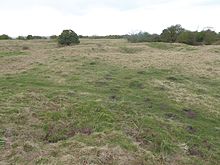| Site of Special Scientific Interest | |
 | |
| Location | Northamptonshire |
|---|---|
| Grid reference | TF 003 038 |
| Interest | Biological |
| Area | 6.6 hectares |
| Notification | 1983 |
| Location map | Magic Map |
The Collyweston Quarries are a 6.6-hectare (16-acre) biological Site of Special Scientific Interest located near the village of Collyweston in Northamptonshire, England. They are known for producing the distinctive Collyweston stone slate, a traditional roofing material that has played a significant role in the region’s architectural heritage. In recent years, the quarries have evolved into vibrant ecological sites with a variety of flora and fauna.
History
Origins and early use
Collyweston stone slate is a sedimentary limestone from the Jurassic period, approximately 140–190 million years old. Unlike metamorphic slate, this limestone naturally splits along its bedding planes, making it suitable for roofing. The material is named after the village of Collyweston, situated centrally within the quarrying area. Its use as a roofing material dates back to Roman times, with archaeological excavations revealing hexagonal slates with single peg holes at sites such as Great Casterton and Godmanchester.
Medieval expansion
During the medieval period, the demand for Collyweston stone slate increased significantly. It became the predominant roofing material within 10 square miles (26 km) of the quarries and was also employed in prestigious buildings further afield. The labor-intensive process of extracting and preparing the slate involved quarrying the stone during winter months, as natural frost action was essential for splitting the stone into usable slates.
Industrial decline and revival
The production of Collyweston stone slate peaked in the late 1800s but declined by the 1970s due to commercial unviability. Traditional methods relied on natural frost action to split the stone, a process that became less reliable with changing climatic conditions. However, efforts to preserve the heritage of Collyweston stone slate have led to the reopening of a slate mine in the village by Claude N Smith Ltd in 2016, after its closure in the 1960s. Advancements by Sheffield Hallam University and Historic England have enabled the revival of traditional slate production methods.
Ecological transformation

Following the decline of quarrying activities, Collyweston Quarries underwent a natural transformation. The main quarry has been repurposed into a nature reserve managed by the Wildlife Trust for Bedfordshire, Cambridgeshire, and Northamptonshire. This 6.6-hectare site, designated as a Site of Special Scientific Interest (SSSI), features rough grassland on Jurassic limestone, supporting a diverse array of flora and fauna. Over a hundred flowering plant species have been recorded, including wild thyme, dropwort, dyer's greenweed and clustered bellflower. There is a substantial butterfly population.
References
- ^ "Designated Sites View: Collyweston Quarries". Sites of Special Scientific Interest. Natural England. Retrieved 2 April 2017.
- "Map of Collyweston Quarries". Sites of Special Scientific Interest. Natural England. Retrieved 2 April 2017.
- "Collyweston Quarries". Wildlife Trust for Bedfordshire, Cambridgeshire and Northamptonshire. Archived from the original on 5 September 2015. Retrieved 2 April 2017.
- ^ "Collyweston Stone Slaters Trust - A Brief History". collywestonstoneslaterstrust.org.uk. Retrieved 4 December 2024.
- Flindall, David (21 April 2021). "The Re-establishment of an Industry: Reroofing Bodley's Court". Donald Insall Associates. Retrieved 4 December 2024.
- "Collyweston Quarries | Wildlife Trust for Beds Cambs & Northants". www.wildlifebcn.org. Retrieved 4 December 2024.
- "Collyweston Quarries citation" (PDF). Sites of Special Scientific Interest. Natural England. Archived from the original (PDF) on 3 April 2017. Retrieved 2 April 2017.
52°37′23″N 0°31′08″W / 52.623°N 0.519°W / 52.623; -0.519
Category: